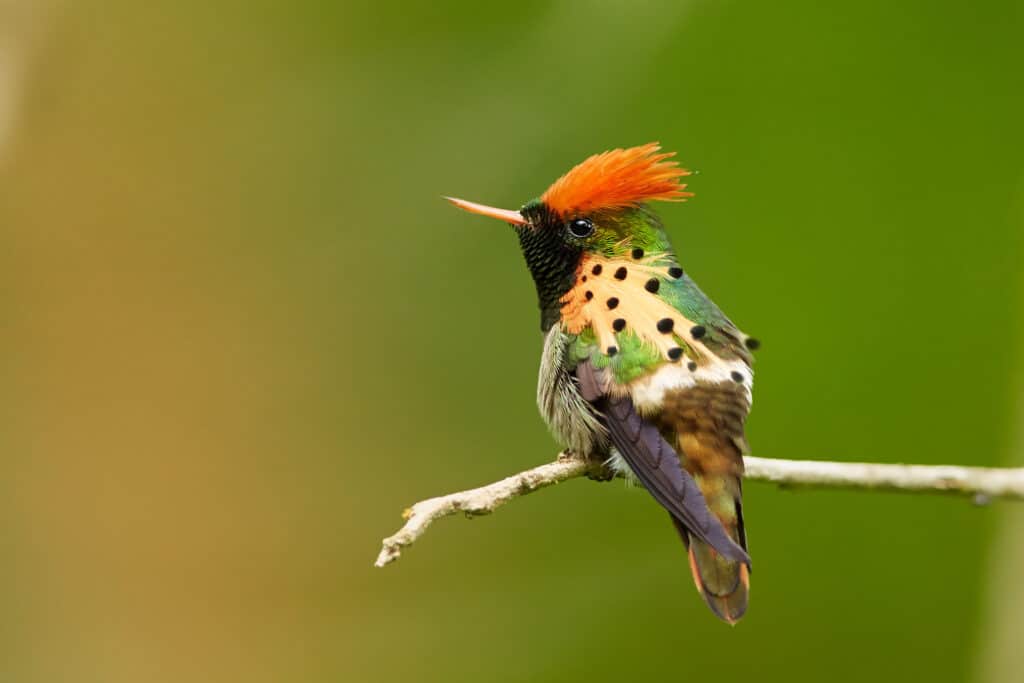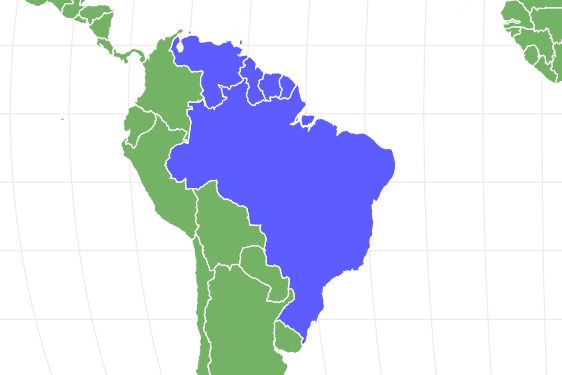Tufted Coquette
Lophornis ornatus
They are tame and easy to approach
Advertisement
Tufted Coquette Scientific Classification
- Kingdom
- Animalia
- Phylum
- Chordata
- Class
- Aves
- Order
- Apodiformes
- Family
- Trochilidae
- Genus
- Lophornis
- Scientific Name
- Lophornis ornatus
Read our Complete Guide to Classification of Animals.
Tufted Coquette Conservation Status
Tufted Coquette Facts
- Prey
- They drink nectar and feed on plant matter and insects
- Main Prey
- Flowering plants and tiny invertebrates
- Name Of Young
- Chicks
- Group Behavior
- Solitary
- Fun Fact
- They are tame and easy to approach
- Estimated Population Size
- Unknown but stable
- Biggest Threat
- Habitat loss and climate change
- Most Distinctive Feature
- Bright-colored plumage
- Distinctive Feature
- Long crests and plumes
- Incubation Period
- 2 weeks
- Age Of Independence
- Around 45 days
- Age Of Fledgling
- 20 days
- Habitat
- Open country, humid forest edges, gardens, thickets, and savannas
- Predators
- Bats, lizards, snakes, jays, crows, ravens, and toucans
- Diet
- Omnivore
- Lifestyle
- Diurnal
- Favorite Food
- Nectar
- Type
- Bird
- Common Name
- Tufted Coquette
- Location
- Northeastern South America
- Average Clutch Size
- 2
- Nesting Location
- On a tree branch hidden in vegetation
View all of the Tufted Coquette images!
“They are often confused with bees because of their tiny size.”
Summary
The tufted coquette is a brightly-colored tiny hummingbird found in the tropical habitats of South America. These adorable birds are tame and easy to approach, but they are relatively solitary and stay to themselves. You can find them hovering next to flowers, sucking nectar, or perusing a backyard feeder. Discover everything there is to know about these fascinating equatorial birds, including their habitats, diet, and young.
5 Amazing Tufted Coquette Facts
- Tufted coquettes are a relatively rare sighting in their habitats. If you do spot one, they will most likely be alone.
- They are tame, friendly, and easy to approach. Plus, they like backyard feeders with sugar water!
- These birds are solitary and do not form pair bonds or flock with other birds.
- Their wings move so fast that they create a buzzing sound.
- Young tufted coquettes follow their mother to learn how to feed themselves.
Where to Find the Tufted Coquette
The tufted coquette lives in six countries in Northeastern South America: Brazil, French Guiana, Guyana, Suriname, Trinidad, and Venezuela. They live in several habitats, including open country, humid forest edges, gardens, thickets, plantations, and savannas. These birds are uncommon in their range; you will typically find them alone, feeding on nectar as they hover over flowers. You can attract them to your backyard by placing feeders with sugar water near a bird bath.
Tufted Coquette Nest
Females select a nest near a nectar source. She constructs a tiny, cup-shaped structure using twigs and plant matter and places it on a tree branch nestled in vegetation around 6 feet above the ground.
Scientific Name
The tufted coquette (Lophornis Ornatus) is in the Apodiformes order, which contains swifts, treeswifts, and hummingbirds. Its Trochilidae family features over 360 birds native to the Americas, most of which inhabit the tropics near the equator. The Lophornis genus is the hummingbird family and si Ancient Greek for “crest” or “tuft” and “bird.” Ornate is Latin for “ornate” or “adorned.”
Size, Appearance, & Behavior

Tufted coquettes are a relatively rare sighting in their habitats. If you do spot one, they will most likely be alone.
©Martin Mecnarowski/Shutterstock.com
The tufted coquette is a tiny hummingbird that measures 2.6 inches long and weighs 0.081 ounces. It has a short black-tipped red bill, a reddish-brown head crest, an iridescent green-coppery back, and a white rump band. It also has orangish plumes with black spots projecting from its neck, a green forehead, and underparts. And the tail is a golden reddish-brown. Females look similar, except they lack crest, plumes, and white rump. Immatures resemble females, but they have white throats with black spots. Tufted coquettes only produce light noises when they feed and are incredibly tame and easy to approach. In flight, their wings are so rapid they make a buzzing sound. When they hover at flowers, their wingbeats are slower and more deliberate. This species is solitary and does not migrate or form pair bonds with other birds.
Migration Pattern and Timing
Tufted coquettes are nonmigratory and stay year-round in their environments. Their lush tropical habitat provides blooming flowers all year.
Diet
Tufted coquettes are omnivores who feed on plant matter and insects.
What Does the Tufted Coquette Eat?
They primarily feed on nectar. But the coquette is a somewhat opportunistic eater and will feed on many flowering plants and tiny invertebrates. They move from flower to flower, drinking nectar, often mistaken for bees due to their minute size and hovering flight. They use rapid wingbeats to steady themselves and can move in any direction, efficiently feeding on their flower choice.
Predators, Threats, and Conservation Status
The IUCN lists the tufted coquette as LC or “least concern.” Due to its relatively large range and stable population size, it does not meet “threatened” status thresholds. While it does not face any serious threats, this species is vulnerable to habitat loss and the effects of climate change.
What Eats the Tufted Coquette?
Due to their minuscule size, tufted coquettes are vulnerable to many animals. Their predators include bats, lizards, snakes, jays, crows, ravens, toucans, and birds of prey. They give high-pitched warning calls when threatened and proceed to “dive attack.” Large hummingbirds may also attack the coquette over food sources. When this happens, the tufted coquette will leave the area.
Reproduction, Young, and Molting
The breeding season depends on the location. In Trinidad, it begins in January and lasts until April. But it runs from December to March in Guyana. Females almost always lay two white eggs and incubate them for two weeks. Females perform incubation and feeding; the male’s role is not well known. She feeds her young by regurgitating food and using her long bill to press it into the chick’s stomach. The young fledge the nest approximately 20 days after hatching, but their mother feeds them for another 18 to 25 days. When they can fly, they follow her to the feeding grounds, so she can show them how to care for themselves. We don’t know their exact lifespan, but most hummingbirds live three to five years on average.
Population
The global population size of the tufted coquette is unknown. It’s presumed to be stable but uncommon, with no declines, extreme fluctuations, or substantial threats.
Up Next:
View all 133 animals that start with TTufted Coquette FAQs (Frequently Asked Questions)
What is the tufted coquette's habitat?
They live in several habitats, including open country, humid forest edges, gardens, thickets, plantations, and savannas.
What countries do tufted coquettes live in?
The tufted coquette lives in six countries in Northeastern South America: Brazil, French Guiana, Guyana, Suriname, Trinidad, and Venezuela.
How small is a tufted coquette?
The tufted coquette is a tiny hummingbird that measures 2.6 inches long and weighs 0.081 ounces.
What color is the tufted coquette?
It has a short black-tipped red bill, a reddish-brown head crest, an iridescent green-coppery back, and a white rump band. It also has orangish plumes with black spots projecting from its neck, a green forehead, and underparts.
Does the tufted coquette migrate?
Tufted coquettes are nonmigratory and stay year-round in their environments.
What do tufted coquettes eat?
They are omnivores who feed on plant matter, nectar, and tiny invertebrates.
What threatens the tufted coquette?
While it does not face any serious threats, this species is vulnerable to habitat loss and the effects of climate change.
Thank you for reading! Have some feedback for us? Contact the AZ Animals editorial team.
Sources
- Red List / BirdLife International, Available here: https://www.iucnredlist.org/species/22687181/130119414

















